Global Selling, Amazon, and beyond
The internet has transformed the world into a global economy. Having goods from all over the world is now as simple as clicking a button. The world economy has been changed by international expansion, which has tightened global relations to form a network through which goods and capital move freely across borders. Every year, the sector expands by leaps and bounds, becoming a significant contributor to the global economy.
Expanding your online business into new markets means more sales and the opportunity to create a truly global brand. According to statistics, the global e-commerce market was worth US$3.53 trillion in 2019. By 2023, this amount is expected to reach US$6.54 trillion. This estimated increase in the value of global e-commerce proves that the industry is here to stay.
Now, let’s say that you’ve already started on a marketplace like Amazon – what do you have to do to expand your business globally? Which marketplace should sellers expand to next? Or what marketplace strategies you should adopt? Because at the end of the day, we want the best possible way to generate revenue.
In this post, we are going to look at the key advantages of selling cross-border on various e-commerce platforms. In addition, we look at the prospects for Amazon sellers in Southeast Asia using marketplaces like Lazada and how relevant is Amazon marketplace for cross-platform e-commerce sellers.
Go Global and Go Home: Why online sellers should expand internationally
These days global multichannel expansion is no longer a “nice to have”. It's important for the world's economies and markets to stay afloat. Forrester estimates that cross-border shopping will make up 20% of e-commerce in 2022, with sales of $627 billion.
Why the increase? Consumers continue to shop across borders to find cheaper goods and to purchase products that aren't available in their local market. As a result, a retailer must export goods and services to customers from other countries. It enables sellers to grow their business internationally.
What are the facts and figures on cross-border trade?
- 54 out of the top 100 global marketplaces did not exist 10 years ago.
- As much as 70% of consumers make at least one international purchase a year.
- Cross-border transactions are being driven by marketplaces.
- The cross-border trade sales were marked to be US$ 300 Billion in the year 2012.
- China is reshaping cross-border e-commerce in North America and Europe.
- More cross-border services are being developed as a result of increased cross-border selling.
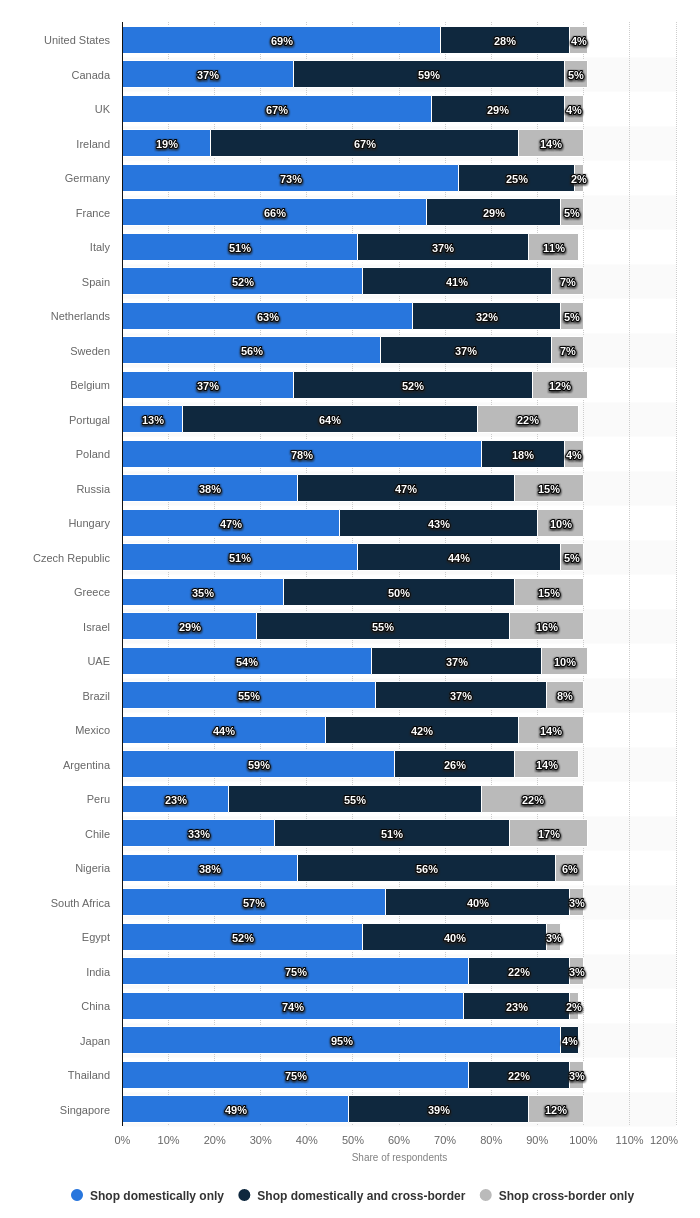
Source: Statista
From what we can see from the cross-border statistics, there is a rise in international sellers and the number is still rising across different countries.
Cross-border activity - where are the Amazon sellers actually based?
Cross-border trade remains strong when it comes to Amazon. Eric Broussard, Amazon’s VP of International Marketplaces and Retail, mentioned that over a quarter of the global revenue generated by sellers on Amazon in 2017 came from cross-border sales. Even though Amazon does not report overall gross merchandise revenue, analysts estimate cross-border sales to be in the $50 billion to $75 billion range.
A large majority of Amazon's revenues come from the US where the company is headquartered and most established. But, as the US market for Prime members becomes saturated and other markets rise in size, the company has turned to international markets for growth, and cross-border sales will help with that.
Not long ago, Amazon finally announced that they will be making business names and addresses of Amazon sellers available to the public. We can now see EXACTLY WHERE sellers are located, thanks to Amazon's policy update.
And guess what?
The number of sellers from outside the United States is almost certainly higher than reported as many companies have registered LLCs in the United States although their operations are mostly outside of America.
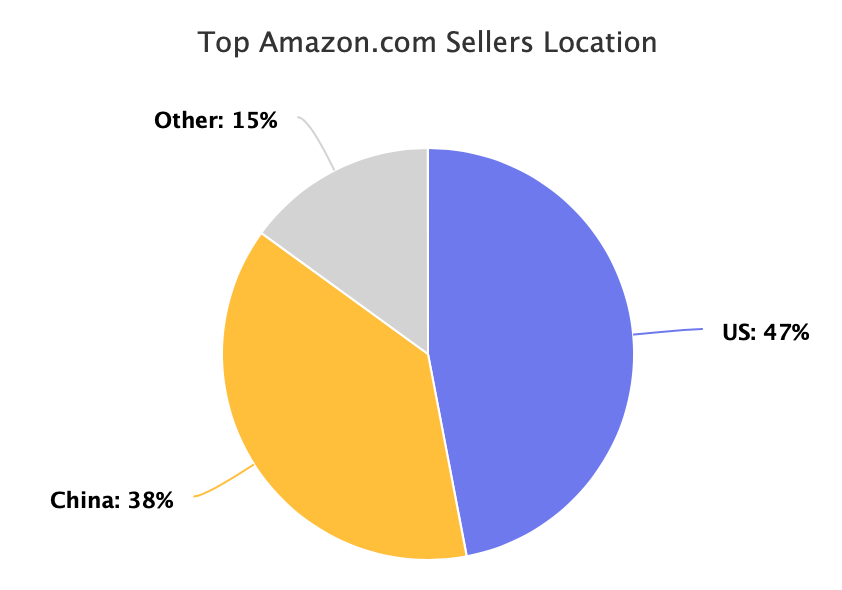
Source: Marketplace Pulse
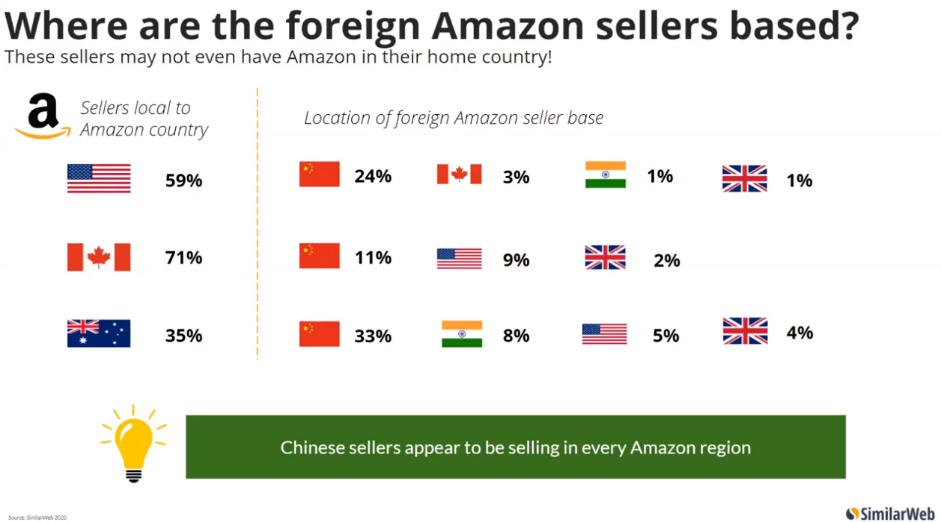
Source: SimilarWeb
How did this happen?
The existence of FBA has allowed Chinese sellers to grow faster as it levels the playing field when competing with sellers local to the domestic market. This allows them to offer the same two-day Prime delivery as domestic sellers; Chinese sellers are therefore more likely than US sellers to use FBA. Just 75% of top US-based sellers use FBA, compared to almost all top Chinese sellers. As a result, the majority of Amazon customers are unaware of the business location of the seller.
No matter where sellers are located, once they’ve signed up for Amazon FBA, they can have Amazon handle all shipping, including returns and refunds, as well as product warehousing in Amazon's warehouses, picking and packing, and other services.
With FBA, sellers can store their inventory at any or all of Amazon's fulfillment centers around the world, with no minimum quantity. When a customer places an order, the item will be delivered from the distribution center closest to them, ensuring prompt delivery.
Where else do Amazon sellers sell?
In terms of Amazon sellers, the expansion market is not always domestic and interestingly, sellers don’t always pick marketplaces within their home country. We refer to this business model as a multichannel marketplace selling in which a merchant sells their products through several different channels.
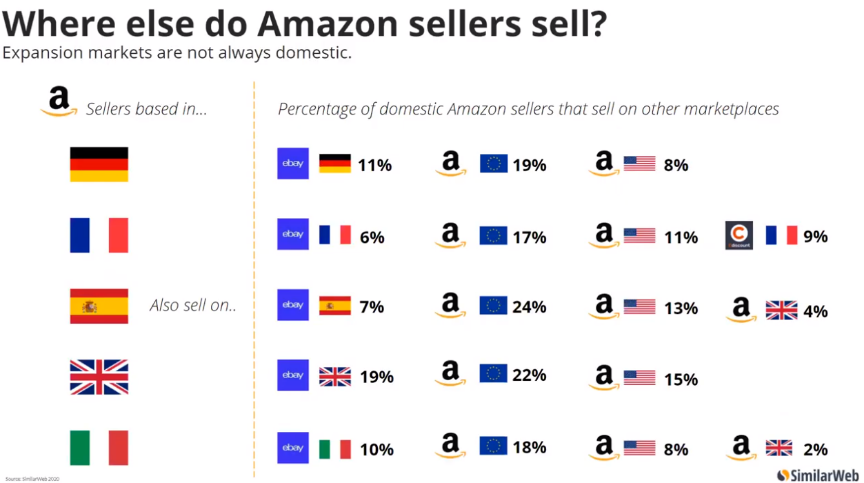
Source: SimilarWeb
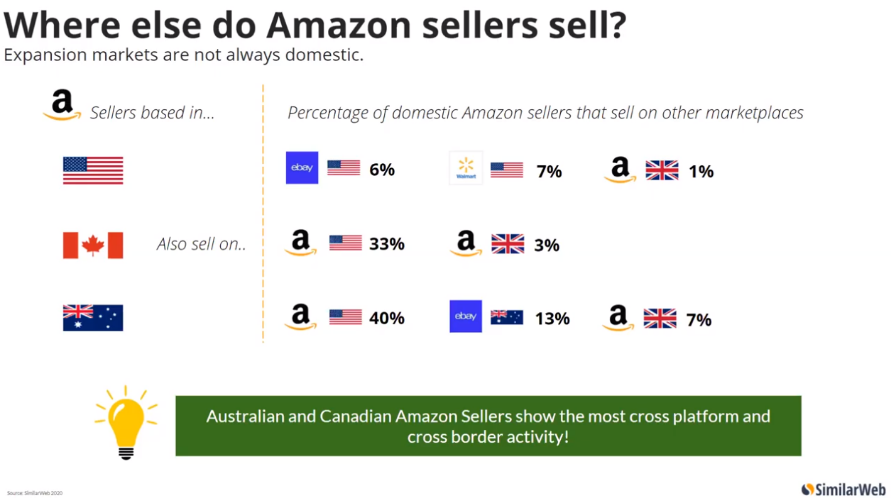
Source: SimilarWeb
What makes cross-border/multichannel distribution doable?
Looking at the graphics above, crossing geographical borders via Amazon and other marketplaces is significantly growing. E-commerce worldwide is transforming into a single unified market. Marketplaces like Amazon, eBay, or Walmart allow sellers to test specific markets, see what works and what doesn't, and make adjustments as needed without the risk of investing a significant amount of time and money into exporting their entire e-commerce site.
Customers too are becoming a sophisticated bunch. They now shop for labels rather than channels, and what used to be showrooming is now web rooming. For them, the distinction between online and offline is becoming increasingly blurred, as is the distinction between geographies. As a result, multi-channel distribution strategies will assist sellers in expanding their international reach and more quickly capturing sales in new markets. Being present on more distribution channels will be beneficial for retailers starting their cross-border journeys.
This now leads to the list of factors to sharpen your thoughts on the cross border/platform selling:
- It’s another way to access more revenue
- FBA makes foreign Amazon markets easy to access
- Multiple markets operate in English
- Ability to reuse content, some marketplaces have simpler content requirements
- Achieve more ROI on product sourcing efforts
If you started your business on Amazon or your own website, you've already put money into inventory, distribution, and operations. You've already decided on prices, taken product photos, and worked out the specifics of your listing.
Now that cross-border e-commerce has proven to be successful, it's time to turn the heat up.
Which marketplace should sellers expand to next?
To be as profitable as possible when selling on cross-border marketplaces, you need to first identify the best online marketplaces for your brand.
Each online marketplace has its own set of specifications, product categories, listing fees, and target markets. So, if you want to make sure you're making the best decision possible, you'll need to do some preliminary testing. You’ll want to understand the different multichannel strategies for selling on marketplaces, which ones hold the most promise for your products, and what you need to do to ensure a smooth start.
The easiest way for existing Amazon sellers to start selling on other marketplaces is to investigate whether those marketplaces have similar demographics, shopper behaviours, and even similar fulfilment centre – just like Amazon’s very own FBA.
Conclusion
A profitable e-commerce company does not have to be devoted to a single platform. If you want to create a successful e-commerce company, multichannel distribution is a must. It's important for diversifying the revenue and reaching out to new customers. Most importantly, it gives you a decent return on your investment.
Equipped with the right knowledge and tool, you can start your journey as a multichannel e-commerce seller with confidence. MerchantSpring can be your trusted tool to help you expand globally. MerchantSpring helps online retailers and sellers to turn e-commerce marketplaces, such as Amazon, eBay, Walmart, Lazada, Zalora, Newegg, TheMarket, Google Shopping, and any of the other hundreds in this category into viable sales channels. MerchantSpring simplifies the process of tracking your store’s performance in one simple and easy-to-use dashboard. Sign up for a free MerchantSpring account today.



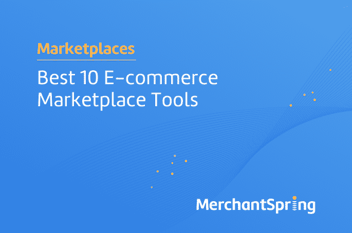




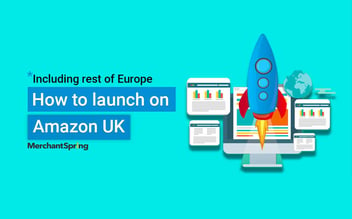

Add a Comment